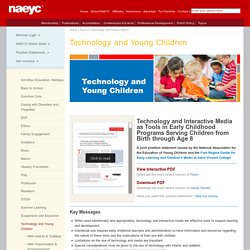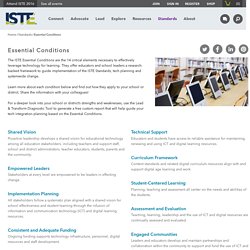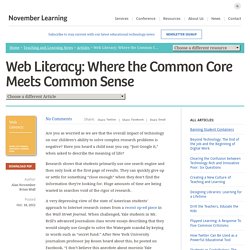

ELA. Fine Arts. Mathematics. Science. Social Studies. World Language. STEM. Open Educational Resources (OER) Project 24 / Homepage. The Guide to Implementing Digital Learning. Examples of Technology Integration with Young Children. Key Messages When used intentionally and appropriately, technology and interactive media are effective tools to support learning and development.

Intentional use requires early childhood teachers and administrators to have information and resources regarding the nature of these tools and the implications of their use with children. Limitations on the use of technology and media are important. Special considerations must be given to the use of technology with infants and toddlers. Attention to digital citizenship and equitable access is essential. View Key Messages Summary (PDF) Examples of Effective Practice View Examples of Effective Practice (PDF) Technology That Supports Early Learning Pre-recorded Webcast: Technology and Interactive Media as Tools in Early Childhood Programs This prerecorded 21-minute webcast addresses key messages in the position statement.
ODE - Teacher Showcase Project Playlist. Office of EdTech - Stories of EdTech Innovation. SETDA - Case Studies 2012. Under current and prior incarnations of the the Elementary and Secondary Education Act of 1965 (ESEA), Congress granted the U.S.

Department of Education specific responsibility to support states and school districts to improve student academic achievement through the use of technology. In 2010, the Obama Administration released its blueprint for the reauthorization of ESEA and in parallel ceased requesting federal budget support for educational technology programs in continuous operation since 1994. In that same year, the U.S. Department of Education made grants under the Race to the Top Assessment program to assist states in developing next generation assessments in grades 3 through 12 in mathematics and English language arts to be delivered online and administered via computer.
The U.S. Select U.S. The Enhancing Education Through Technology (EETT) Program The Enhancing Education Through Technology state educational technology grants program (Title II, Part D, of ESEA) was the U.S. Find, create and share lesson plans and teaching tools to empower your classroom. Essential Conditions. Shared Vision Proactive leadership develops a shared vision for educational technology among all education stakeholders, including teachers and support staff, school and district administrators, teacher educators, students, parents and the community.

Empowered Leaders Stakeholders at every level are empowered to be leaders in effecting change. Implementation Planning All stakeholders follow a systematic plan aligned with a shared vision for school effectiveness and student learning through the infusion of information and communication technology (ICT) and digital learning resources. Consistent and Adequate Funding Ongoing funding supports technology infrastructure, personnel, digital resources and staff development. Equitable Access. Teach your students the right way to Google. Kelly Maher November 24th, 2014 In the age of the split-second Google search, it’s more critical than ever to train students to distinguish between primary and secondary sources As in decades past, proper research methods are an essential skill for today’s students.

At a time when most students (and adults, for that matter) are accustomed to heading straight to Google to answer all of their questions, being able to sagely sift through the good, the bad, and the ugly of search results is key to creating independent 21st century thinkers. However, even when used properly, Google is not always the right resource. On its website, the Kentucky Virtual Library provides a detailed, student-friendly interactive map of the research process, called “How To Do Research,” which spells out the steps for making the most of the research process, from planning to searching to taking notes and ultimately using gathered information effectively. Web Literacy: Where the Common Core Meets Common Sense. Are you as worried as we are that the overall impact of technology on our children’s ability to solve complex research problems is negative?

Have you heard a child near you say, “Just Google it,” when asked to describe the meaning of life? Research shows that students primarily use one search engine and then only look at the first page of results. They can quickly give up or settle for something “close enough” when they don’t find the information they’re looking for. Search Education – Google. Ingredients for effective teaching.
Web Literacy Education for Educators - November Learning. TICAL - Technology Information Center for Administrative Leadership. NETS Implementation - home. App Evaluation Rubric. App Evaluation Rubric for Students. Ways to Evaluate Educational Apps. I am conducting a series of workshops in Florida and was asked to share a rubric to help teachers evaluate educational apps as part of the workshop.

In 2010 Harry Walker developed a rubric, and I used his rubric (with some modifications by Kathy Schrock) as the basis for mine. (Read Harry Walker's paper Evaluating the Effectiveness of Apps for Mobile Devices.) I kept in mind that some apps are used to practice a discrete skill or present information just one time. Others are creative apps that a learner may use again and again, so it's a challenge to craft a rubric that can be used for a wide span of purposes. I tried to make my rubric work for the broadest range of apps, from drill and practice to creative endeavors, while stressing the purpose for using the app. My rubric also emphasizes the ability to customize content or settings and how the app encourages the use of higher order thinking skills. Here's what I chose to spotlight in my rubric: Relevance Customization Feedback Engagement.
Resources for Digital Learning Day & Beyond.